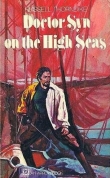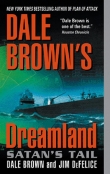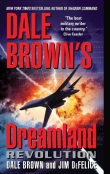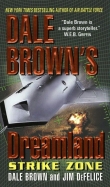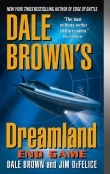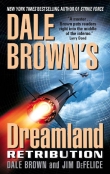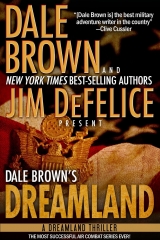
Текст книги "Dreamland"
Автор книги: Dale Brown
Жанр:
Боевики
сообщить о нарушении
Текущая страница: 6 (всего у книги 21 страниц)
He missed.
By a centimeter.
Klondike frowned. “Perhaps the weapon takes getting used to. Ordinarily, you should get to seven hundred yards before beginning to lose some accuracy. It is, of course, a matter of skill, and choosing the right ammunition. No offense, Captain.”
“How the hell does this work?” Danny asked. “Is it a laser?”
She shook her head. “A focused magnetic pulse, two signals with a Doppler effect. If it were a laser you would have optical problems shooting through glass or water.”
“You can aim through glass?”
“Without manual correction. There are limitations, of course. The device cannot read two-dimensional shapes, and has difficulty with thin surfaces. You could not read a sign with it beyond sixty-two meters. The distance has to do with the harmonics of the different radar waves,” she added. “The sight would also be theoretically vulnerable to a system such as the HARM, which can home in on it. Still, until we perfect smart bullets—if we perfect smart bullets—it’s the most accurate handheld ballistic device available. I’ve done a little work on the barrel,” she added. “And, of course, the bullets are mine.”
“I have six guys on the Whiplash response team,” Danny told her. “I’d like to qualify each one of them on the gun.”
“It is a sniper’s weapon, Captain. At some point in the future, perhaps, we will be able to mass-produce it. For now there is exactly one available for use.”
“All the same, I want them checked out on it, if possible.” Freah’s Whiplash response team was an elite subgroup of his air commandos, cross-trained for a variety of jobs. Organized only in the last six months, they hadn’t been called into action yet, with the exception of one training detail. But it was accepted that each member would be trained and expected to take on any other member’s job at a moment’s notice.
“As you wish. I suppose you’ll be wanting body armor as well,” said Klondike.
“We have flak vests.”
“Captain, please.” She shook her head. “Your vests are made from KM2, correct?”
“Well—”
“They weigh more than twenty-five pounds, and I doubt that half your men wear them half the time, no matter what the standing orders or situation may be. Our armor, on the other hand, is made of boron carbide plates and a thinner, stronger Kevlar derivative. Unfortunately, there’s some loss of flexibility in our version, and we’ve only fashioned vests so far. Nonetheless, you’ll find they weigh less than ten pounds, and can stop a 30mm shell fired from point-blank range.”
“I’m in your hands, Annie,” said Danny.
“Yes, well, don’t get fresh,” said Klondike, leading him out of the room.
Dreamland
11 October
COLONEL BASTIAN WALKED AROUND THE CHUNKY airframe that sat in the middle of Development Shed B/3, trying to hide some of his displeasure from Rubeo and the others he had gathered on the tarmac for this impromptu brainstorming session. To him, the F-119 looked like a flying tugboat.
A barely flying one, given its performance specs. Mike Janlock, an aeronautical engineer who specialized in BMI resin airfoils, had just finished saying that a handful of alterations would turn the aircraft into a robust attack weapon. But those changes would make it unusable aboard aircraft carriers, as well as highly unlikely to meet the Marine Corps requirement for vertical landing at forward combat weight.
Janlock and the others had said over and over that there were three pretty good planes locked inside the F-119 airframe. Choose one—hell, even two—and America would have a cutting-edge aircraft capable of filling a wide variety of attack roles for the next two decades.
But Dog’s mandate was clear. He had to proceed with all three. Congress was so high on the project that yesterday afternoon a Congressional committee had voted to increase F-119 funding three hundred percent.
The same committee had postponed a decision on Dreamland, per the recommendation of the Joint Chiefs and Ms. O’Day.
If Dreamland survived, it would get a good hunk of the F-119 development money. Bastian’s new “all ranks” mess halls—already a hit—could dish out all the fancy food they wanted for the next ten years.
But damn. The plane was a flying tugboat. Hell, it was one of those five-hundred-dollar hammers the media claimed the Pentagon was always buying.
“Colonel, you were saying?” prompted Rubeo.
“A survivable tanker,” repeated Bastian. “The thinking is to replace KC-10 Extenders and HC-130’s at the same time. It would be connected to the JSF project.”
“So it has to be fast and slow,” said Janlock.
He didn’t mean it as a joke, but everyone laughed. Except Rubeo, of course.
“Seriously, if we did have one aircraft that could refuel helicopters as efficiently as CAP aircraft, in combat situations as well as on ferry flights, it would be a hell of an asset,” said Bastian, reining them in. “I can tell you from experience, a fighter with battle damage can have trouble reaching normal tanking altitude and speed. KC-135 and KC-10 tankers did a hell of a job during the Gulf War, doing things they weren’t technically capable of. I’d say more than a dozen lives were saved. At least. And ten times that number of planes. So what we’re talking about, if you guys could pull it off—the potential would translate into a lot less orphans and widows. I realize it’s not the conventional thinking, but I’ve seen what you guys can do.”
With the exception of Rubeo, who was wearing his customary scowl, the engineers and officers nodded their heads. They hadn’t thought about the problem in those terms before.
“What if we take the C-17 apart?” asked Jeremy Winters, a tall engineer with a hawk’s nose and thick, wire-rimmed glasses. “Good capacity, short takeoff so we can use forward bases.”
“Piffle,” said Rubeo.
“All right, Doc,” snapped Bastian, who’d had enough of the scientist’s chronic pessimism. “What do you suggest?”
“It depends on our goal,” said the scientist. He pursed his lips as if he had just bit into a lemon. “If our goal is simply to sustain funding, I suggest we take any aircraft we’re interested in and claim that it should be studied as a tanker.”
“All right, that’s enough,” said Bastian. “I’ll deal with the politics. I want real ideas here, not fodder for Congress.”
“Colonel, you and I both know that the JSF is our lifeline,” said Rubeo, refusing to back down. “And charitably put, it’s a camel. So the most optimum solution would be another camel. But as for a survivable tanker”—the scientist’s voice rose an octave as he finally made a serious point—”the C-17 is a large and easily hit target. There is no way to change that.”
“Escorts could protect it,” said Smith. “Going to need them for the JSF.”
Uncharacteristically, Smith hadn’t said much at all. Dog suspected that he had decided to say as little as possible about the JSF now that he was leaving; probably he was watching his political backside.
Smart, even though it pissed Bastian off.
“We already have a project study for a survivable, deep-penetration tanker on the shelf,” said Major Nancy Cheshire. “It would need some work for low-speed refueling, but it would certainly meet the requirements for near-Mach speed, high-altitude regimes.”
“What are we talking about?” Bastian asked, still glaring at Rubeo.
“The Megafortress KC.”
Rubeo opened his mouth to object, but Cheshire cut him off.
“Some studies were done two years ago, but they never went anywhere. The idea was that we would need something that could keep up with the flying battleship concept, refueling it in a hostile environment,” she explained. “Survivability was an important consideration and on that score, I know the plane got high marks.”
“Megafortress, back from the dead,” said Rubeo.
“What’s your objection to that idea?” Bastian asked the scientist.
“None as far as the specific plane goes,” said Rubeo, surprising Bastian. “My objection is one of principle. The Megafortress—all manned aircraft are redundant.” He folded his arms in front of his chest. “Colonel, if you’re looking to tie a project to the F-119’s tail, tie the Flighthawks. They’re the future.”
“We’ve been down that road,” said Bastian. “And in any event, the robots can’t even refuel themselves.”
“Piffle. We simply haven’t thought about it properly.”
Dog wanted his people to feel that they could speak freely; he didn’t want a group of yes-men and suck-ups around him. And he knew that for a place like Dreamland to succeed, discipline had to be pretty loose.
But Rubeo really pushed the envelope.
“I appreciate your comments, if not your tone,” Dog told him. “The debate about robot planes isn’t relevant at the moment.” He turned back to Cheshire. “How far along was the tanker project?”
“I don’t know that it got beyond one or two proof-of-concept flights,” she said. “But I’ in sure it wouldn’t take much to dust it off.”
“The plane kicks out some fierce vortices,” said Jan-lock. “We barely have them controlled enough for stable flight. We all saw how difficult it was to handle without the flight computer. If anyone other than Rap was at the controls when the gear crashed, we would have lost the plane.”
“Okay,” said Bastian. “Let’s find out.”
“Even though Fort Two and the others have been cleared for operations, we’re not one hundred percent sure the voltage spikes were due to the Army tests,” said Jennifer Gleason, one of the computer scientists. Her main assignment was the Flighthawks, but she had also had a hand in designing the advanced flight-computer components Fort Two was testing. “There are at least three other possibilities. We really ought to work through the test regimes to make sure.”
“I’m confident that was the problem,” said Cheshire. “And with the shielding and the backups, I think we’re fine. Fort Two is due for a check ride this afternoon.”
Bastian glanced at his watch. It was a little past ten o’clock. “I need to know by 1800. Doable?”
“Absolutely, sir,” said Cheshire. “Rap should be getting suited up as we speak.” She turned to Gleason. “We can run through some of your tests—all of them—at the same time.”
Gleason nodded—clearly reluctant, but nonetheless in agreement.
“So this our first choice,” said Bastian. “Choice number two, I take it, would be to study the C-17.”
“Not our project,” hissed Rubeo. The implication was clear—a C-17 tanker wouldn’t help keep Dreamland alive.
“Yes, well, there’s nothing we can do about that,” said Dog. “Anyone has any other ideas, let me know ASAP. In the meantime, let’s get this done.”
SEVERAL HOURS LATER, KNIFE SAT IN THE HANGAR where the conference had been, staring down from the F-119 cockpit. He was waiting for the security officer to green-light the plane from the hangar. A Russian optical satellite was just completing its overhead tour. The satellite was an old Kronos model incapable of resolutions greater than a meter in diameter, but Dreamland’s operating protocols strictly prohibited the F-119 from being on the runway while it was overhead.
Ordinarily, Smith would be more than a little impatient to get going. But this afternoon he was feeling almost a little nostalgic. He’d gotten word just before suiting up that he was to expedite reporting to Wing A; an Air Force transport due to take off from Nellis at ten that evening was holding a seat. So this would be his last flight at Dreamland, as well as in the F-119.
The Congressional committee’s decision on the F-119 didn’t particularly surprise him; the project’s various contractors had plants in over 150 Congressional districts, which added up to a hell of a lot of muscle, if not brains. That was the way appropriations went these days.
Smith had decided he was in a no-lose position on the JSF. If the program continued and the F-119 was finally cleared as a production model, his resume would note that he had helped develop it. If it was killed as an ill-conceived project—which, in his opinion, it was—he could point to the fact that he had seen this and gotten out. His final reports on the project would be worded so vaguely that they could be used to support either scenario. In the meantime, he’d be doing some real flying, and probably—though admittedly not definitely—adding good notes to his career folder.
He was learning this political game well.
The lieutenant at the front of the hangar said something into his walkie-talkie, then gave the up-and-at-’em wave to the crew. The tractor sitting in front of the F-119 cranked her engine; Knife let off the brakes and he began to roll out onto the tarmac. The fighter’s engines had to be started from an external power cart or “puffer.” Three crewmen had the cart in place almost as soon as the plane and its tow truck stopped in front of the hangar. They moved quickly; the crew chief pumped his arm in the air and, bam, Knife had his engines up and running.
Mack ran through his instrument checks, working swiftly with the no-nonsense rhythm he’d perfected during his days flying combat air patrol in the Gulf. With the systems at Dash-One spec, he asked for and received clearance from the tower. He tapped the top of his helmet for good luck—a necessary part of his preflight ritual—then began trundling toward Lakebed Runway 34. A black Hummer and a Jimmy, both with blue security lights and yellow “Follow Me” signs, led the way. Off to the east a temporary aboveground control tower and observation deck had been erected to monitor the flight.
Knife narrowed his attention to the small bubble around him as the vehicles peeled off. He pushed the F-119 to its mark, setting his brakes for one last systems check before takeoff. The right panel of his trio of multi-use displays was entirely given over to flight details. His eyes scanned the graphical readouts deliberately. Satisfied, he turned his eyes toward the left MUD, where he had the GPS system selected. The enhanced God’s-eye-view screen rendered his plane as a blue dot on the color-coded terrain—in this case a brownish topo map overlaid by a gray rectangle signifying the limits of the test range. Groom Mountain’s seven-thousand-foot-high peak lurked at the far end, drawn in sharp black lines. Smith shifted his thumb on the Hostas stick, adding radar input to the display; the shading changed to indicate that it was working, though it couldn’t properly paint anything until he was over four hundred feet above ground, and couldn’t really be trusted until about eight or nine hundred.
Something for the engineers to work on.
Ready, Knife thought. His left hand moved the throttle to maximum military power. The plane trembled as the turbines spooled, the brakes straining.
Temp, RPM, pressures perfect. Good to go. He backed to idle, took another breath, gave himself another good-luck pat.
Not that he needed it, of course.
“Tower, Playboy One, I’m ready for one last fling,” he said.
“Playboy One,” acknowledged the controller stiffly.
Knife released the brakes and spooled takeoff power, his mount rumbling forward.
BREANNA BANKED NORTHWARD, HEADING TOWARD Range F where the rendezvous was supposed to take place. The check flight and tests had gone well, but she could feel her stomach pinching her as they got ready for the rendezvous.
Maybe it was just the ham sandwich she’d managed while they orbited out of the Russian satellite’s view, waiting for Smith and the F-119 to take off. Mustard always gave her indigestion. Everyone else was raving about her father’s decision to spread the expertise of the executive chef among all of the base’s cafeterias, but in her opinion the food at Dreamland still rated among the worst in the world.
“Optimum, optimum, optimum,” sang her copilot as he ran through his check of the flight systems. Two of Dreamland’s top techies were performing similar checks in the former radar and navigation suite below. The weapons bay was unoccupied, except by the computers.
Sitting behind Breanna and Chris on the flight deck was Major Cheshire, who was overseeing the refueling exercise. The Megafortress’s synthetic bird’s-eye view, created from radar inputs, was projected on one of her monitors. Another carried the input from a video cam installed at the rear of the plane, roughly where a refueling boom would be. With her corn unit set to Playboy’s frequency, Cheshire would pretend to be a boomer, talking the attack plane in for a tank. It was ad hoc, of course—there was no boom, and Major Smith had no lights to guide him under Fort Two’s belly. But they just needed a rough approximation to make sure the concept was sound.
Breanna reached Range F at twenty thousand feet, precisely as planned for the first track. It bothered the hell out of her that the world’s most versatile bomber might only survive as a milk cow. But as Cheshire had said when she explained the mission, better a live cow than a dead dream.
“We’re ready any time you are, Major,” she told her boss.
KNIFE STOMPED THE RUDDER PEDAL IN A LAST, desperate effort to close in to the target cone below Fort Two. His right wing pulled up, propelled by a nasty eddy of air from the Megafortress’s fuselage. He steadied it for a second, then felt the plane starting to lose speed and got a stall warning.
“Shit,” he said, out loud and over the open circuit as he ducked the plane off the EB-52’s tail.
“Okay, let’s take a break,” said Major Cheshire.
“Roger that,” he snapped.
They’d been trying for nearly thirty minutes to get the F-119 under the Megafortress’s belly. The vortices and wind sheers coming off the bigger plane’s wings, fuselage, and tail were just too much for the F-119, even with its constantly correcting fly-by-wire controls.
Knife thought the controls themselves might be the problem. In his opinion, having a computer between him and the plane’s control surfaces dampened the edge he needed to put the plane precisely where he wanted. It was like the difference between driving an automatic-shift and a standard-shift car; being able to flutter the clutch or hold the revs above redline without shifting could make all the difference.
But it wasn’t like he could turn the system off. Like other inherently unstable craft such as the F-117, the fly-by-wire system was an integral part of the design, not an enhancement like in the EB-52. The JSF couldn’t fly without it.
What had Bastian called it? A flying bathtub? Have to give Dog his due—he had that nailed.
“Let’s move on to the drogue routine off the left wing,” Knife radioed. “Stay at twenty thousand feet.”
“You sure?” asked Cheshire.
“Look, you guys just follow the script, all right?”
“You okay, Major?” asked Cheshire.
Smith reminded himself the project was being monitored down in the tower.
“Yeah, okay. Let’s go,” said Smith. He began closing in on the Megafortress’s left wing, now nearly a half mile ahead. He came in ever so slowly, drawing even with the tail—then found the plane sheering off to the left into a rapid spin.
His master warning panel freaked. He fell to nearly fifteen thousand feet before he could manage a recovery.
“Playboy, you have visible damage to the leading-edge aileron on the right wing,” said Cheshire. “Copy? Knife, are you okay? Are you with us?”
“Roger that,” he said. The plane’s high-flying position—the pilot sat in what looked like a glass bulb at the top of the plane—gave him a good view of the wings. Finally sure he had it back under control, he twisted back and forth, doing a visual inspection to confirm Cheshire’s warning and the legion of problem codes on the systems screen. The leading-edge surface was bent, and he could see a piece of metal extending out from behind it. He guessed that was part of one of the motors that worked it, which the screen warned had failed. Now he had to admit that the FBW system was useful—it was compensating so smoothly for the damaged wing that he barely noticed it. Undoubtedly the flight-control system had played a big role in helping him regain control of the craft.
Though serious, the damage wasn’t fatal. But his gauges showed the temperature in his right engine had shot up to the redline; there must be a problem there as well.
Stinking F-119. What a way to go out.
Appropriate, though, considering the plane.
“Dream Tower, this is Playboy One. Emergency declared. I have a slight situation with my wing and engine. Looks like it’s time to land,” Mack said, adding his altitude, position, and heading, though they would already be projected by Dreamland’s powerful sensors. He and Fort Two had the sky to themselves; all he had to do was line up, pop his wheels, and land.
“Tower acknowledges, Playboy. Copy your flying emergency.”
“Mack?”
Brenna’s voice seemed to come at him from the clouds, breaking through the outside fuzz of his consciousness as he pushed toward Runway Two. He felt the kiss again, then returned to the matter at hand.
“I’m okay, beautiful,” he told her. “I can’t even tell there’s a problem. But listen, do I get a kiss if I land in one piece?”
COLONEL BASTIAN STOOD BACK FROM THE MONITOR, nudging next to the air-conditioning unit in the cramped quarters of Dreamland’s mobile test tower. He could see Smith’s plane coasting toward the hangars in the distance. Obviously, the damage to the plane had been minimal.
The damage to the idea of using the Megafortress as a tanker, however, was another story.
But he had decided this morning that he definitely wanted to keep the Megafortress project alive. It wasn’t just the fact that he believed in McLanahan’s Air Battleship scenario. Even as a “simple” bomber, the Megafortress made sense. With a few tweaks, it could be as survivable as an F-15E while carrying several times the payload two or three times as far. Get into a low-intensity war in a hot climate—say, the Middle East, as McLanahan had hinted, or Southeast Asia—and a few Megafortresses might just turn the tide. And it would be cheap; the Air Force had literally hundreds of B-52’s available for conversion.
At the moment, though, that was a drawback. There weren’t enough jobs at stake to easily apply political pressure and keep it alive. But attach it to the F-119 as a survivable tanker, and there’d be plenty of pots. A few months of demonstration flights, maybe some careful work with contractors, and they’d have enough political support to revive the battleship concept.
But it was dead now.
Bastian listened as the controller exchanged information with an aircraft conducting a test near Range F.
“What’s going on?” he asked Mickey Colgan, the flight officer coordinating the day’s tests.
“Oh, that’s just a drone taking off,” said the captain. “Unpiloted Green Phantom doing IR testing. Pretty straightforward. It’s got a JSF suit on. It has to catch another drone.”
“I’m not following you.”
“I’m sorry, Colonel. There are two Phantoms. One’s just a stock drone. The other, Green Phantom, has some wing baffles and a few other mods to simulate the F-119’s flight characteristics. They’re controlled out of the Flighthawk hangar. We’re running checks on the nitrogen-cooling system for the gear in the IR’s eye. It has to be kept at a constant temperature or—”
“You think Green Phantom could rendezvous with Fort Two?”
Colgan blinked. “Well, if the F-119 can’t do it, that old Phantom, I mean, it’s at least as bad a flier as the JSF itself.”
“Who’s the pilot?” asked Bastian.
“That would be Major Stockard, sir.” Colgan seemed to bristle a bit. “They, uh, they’re trying to get him back into the swing of things.”
“How good a pilot is he?”
“Sir?”
“I mean with the drone.”
“Well, before his accident, there was no one near as good as him,” said Colgan. “But …”
“But what?”
“I don’t know if he’s back up to speed, Colonel. And he, uh, he’s in a wheelchair.”
“What’s the frequency to the Flighthawk bunker?” said Bastian, moving back to the corn panel.
* * *
TO SAY HE’D FLOWN THE QF-4 DRONE TEN THOUSAND times wasn’t an exaggeration; Zen had learned to control the Flighthawks with the exact airplanes he was flying. He’d gotten so he could work them with his eyes closed before moving up to the much-more-difficult-to-control Flighthawks.
He closed his eyes now in frustration. The gig was simple—all he had to do was fly Green Phantom behind Phantom One-Zero-Mike at fifteen thousand feet with three miles of separation. Piece of cake.
Except his heart was pounding and there was sweat pouring from his wrists, and if it weren’t for the automated flight computer fail-safe, he would have smacked Green Phantom into the ground on takeoff.
Things had gone badly yesterday, but that at least could be attributed to rust; he’d gotten better as the exercises wore on.
He wasn’t sure what to blame this on. Maybe the F-119 mods. JSF wasn’t exactly the world’s most flyable plane, and Green Phantom was a pig’s pig.
It was easier to handle than two Flighthawks at supersonic speed, though. So why was he sweating like a bull being chased by toreadors?
If he couldn’t make this simple intercept, how could he ever control the U/MFs?
Zen rolled his neck around on his spine, the vertebrae cracking. He’d forgotten how heavy the control helmet was. He could actually take it off, since the console he was sitting at in Hanger B was basically a flight simulator on steroids. Arranged like a cockpit and developed for the Flighthawk, its standard multi-use displays were augmented by dedicated control and sensor displays, along with banks of specific system overrides and data collectors. They’d nicknamed it Frankenstein’s Control Pod.
But if he was going to get back in the program, he had to do it right, and that meant using the helmet and the Flighthawk flight sticks. It meant sucking it up and hanging in there, kinks, sweat, and all.
Zen checked the altitude on Green Phantom, nudging up to 15,500 feet. He was five miles away, closing on One-Zero-Mike’s left wing. Though he had his left hand wrapped around Mike’s control stick, the computer was actually flying the plane in its preprogrammed orbit. Zen nudged his right hand back slightly, gently climbing.
Piece of cake. Two miles to go. He moved his thumb to the center of the stick’s oval top, keying the view screen from optical to FLIR input. The view at the top of his screen changed to a greenish tint, the world shading according to heat sources.
Driven by his preprogrammed flight plan, One-Zero-Mike began to bank. Zen started to follow, jerked his hand too hard, cursed, and then almost lost Green Phantom. The muscles in his fingers froze. He pushed the computer-assist lever at the base of the assembly, too embarrassed to use the voice command and acknowledge that he had blown it. The computer immediately grabbed the plane, putting it onto the preprogrammed course.
“Zen?”
“What?” he snapped over the headset.
“I have Colonel Bastian on the circuit,” replied Fred Remington, one of the civilians helping run the tests. “Something’s up.”
“Yeah, okay.” Zen’s pinkie stretched to click down the lever at the front base of his right stick; it automatically engaged computer control for Green Phantom. “Let me talk to him.”
“Major Stockard, do you think you can do me a favor?” said Bastian as soon as the line snapped open.
“Colonel?”
“I wonder if you have enough fuel in Green Phantom to try a rendezvous with Fort Two on Range F. We’d like to see if you can get close enough for a refuel.”
Zen glanced at the gauge. The Phantom had plenty of fuel.
But getting close to a Megafortress was not exactly easy. Even the Flighthawks had trouble.
A Phantom with JSF mods? Ha.
And forget about the plane—he’d just blown an easy run at a drone.
Zen didn’t know what to say. “You’re looking for that to happen right now?”
“Can you do it?”
“Green Phantom simulates the F-119.”
“That’s exactly the point. We want to mock up a refuel off a Megafortress. Mack Smith had some trouble,” added the colonel. “I’d like a second opinion.”
“I’m on it,” snapped Zen.
BREANNA TOOK FORT TWO OUT OF ITS ORBIT AT 25,000 feet, gliding gently on its left wing to twenty thousand smack in the middle of the range where the new exercise would take place. She pushed the big plane into place, gingerly nudging its nose so it slotted exactly along the three-dimensional flight line the computer was projecting in the HUD navigation screen. They were mimicking a standard tanker track, flying a long oval in the sky as if they were a KC-10 Extender or a KC-135 Stratotanker on its anchor near a war zone, waiting for attack planes and fighters returning from action. Neither Chris nor Major Cheshire had said anything since the colonel ordered the new trial.
Zen had said exactly four words over the radio, but the tension in his voice practically drilled a hole through her skull.
“Green Phantom, we have you at eighteen thousand feet, on beam, closure rate at two hundred knots,” Cheshire told Jeff.
The robot Phantom was going approximately a hundred miles an hour faster than it should have been. Breanna flipped her HUD plot that showed the plane approaching behind them. Its speed abruptly slowed, but Green Phantom was still flying too fast to get into the refueling cone. She resisted the temptation to hit the gas, knowing that would only make things more confusing for Zen.
“Three miles,” Cheshire said. “He’s not going to make it.
Breanna could feel Chris staring at her. She continued to hold her position.
GREEN PHANTOM JUST WOULDN’T SLOW DOWN. ZEN nudged the throttle push-bar on the underside of the one-handed stick control. The thrust-indicator graph at the right side of the screen obstinately refused to budge.
He could tell the computer to lower power. He could tell it precisely how many pounds of thrust to produce—or, for that matter, what indicated airspeed he wanted. But using verbal commands, relying on the computer—it seemed like giving up. And he wasn’t giving up. He was doing this, and he was doing it himself.
Partly because Smith had failed. And partly just because.
He tapped the glider with his finger. Finally the robot’s speed began to drop, but it was too late.
“Breakaway, breakaway, breakaway,” Zen said calmly on the interplane frequency. The “breakaway” call mandated full military throttle and an immediate one-thousand-foot climb by the tanker aircraft, and idle power and a one-thousand-foot descent by the receiver. Zen purposely used a calm tone of voice instead of an excited one to communicate to Bree and Cheshire that there was no imminent danger. When he was level, he said, “Let me try another shot.”
